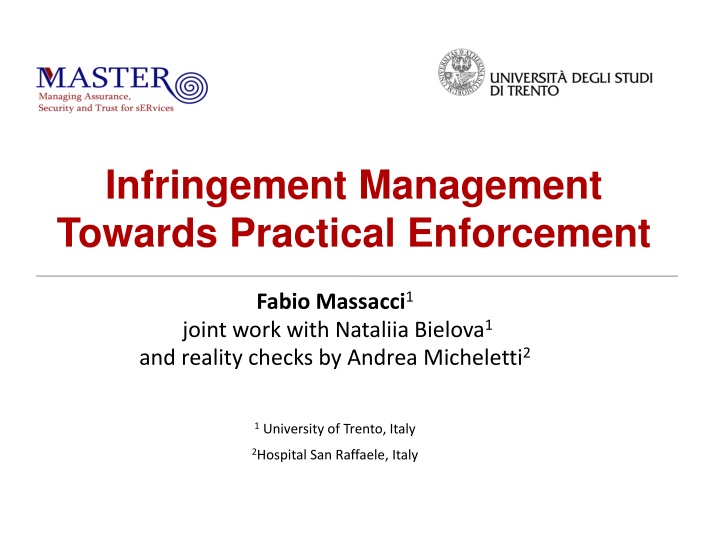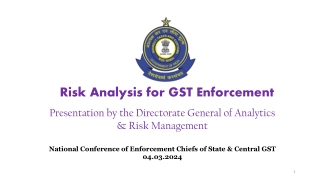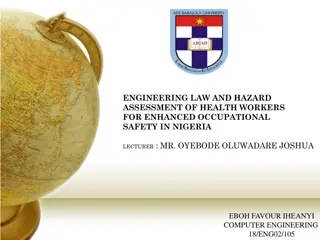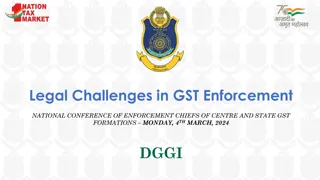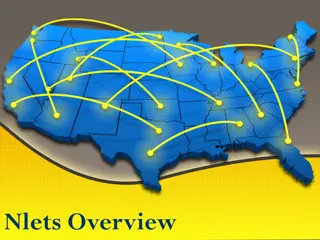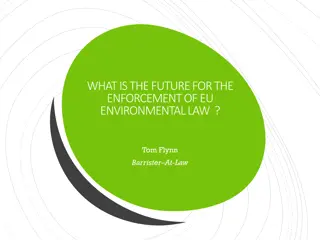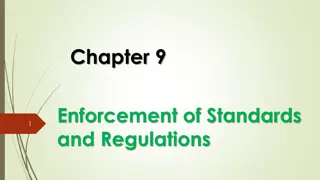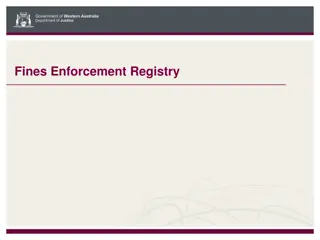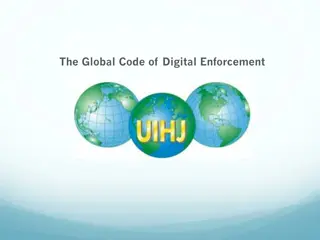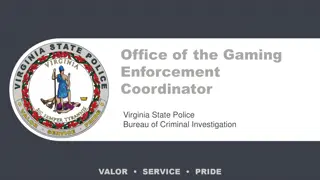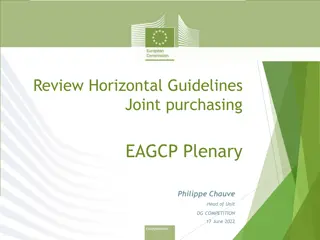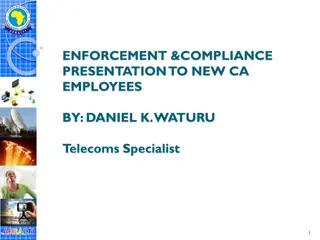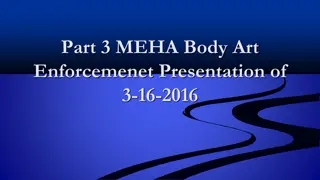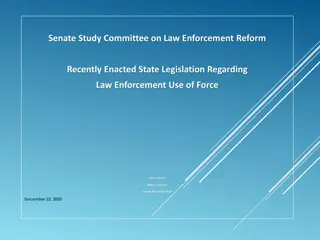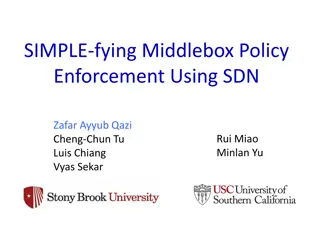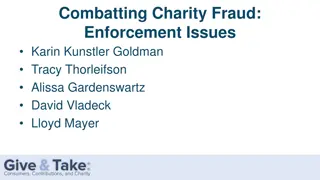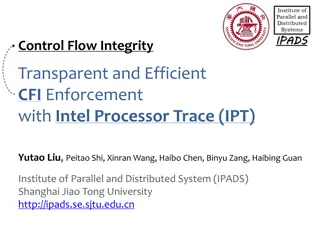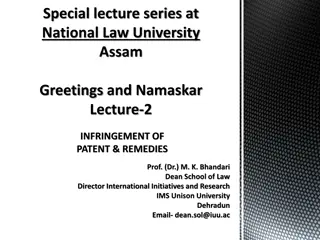Challenges of Practical Enforcement in Infringement Management
The study delves into the complexities of practical enforcement in infringement management, highlighting the challenges faced by researchers and co-authors Fabio Massacci, Nataliia Bielova, and Andrea Micheletti. Through a series of exercises and theoretical explorations, the team uncovers potential flaws in existing theories and mechanisms, questioning their efficacy in ensuring soundness and transparency in enforcement policies.
Download Presentation

Please find below an Image/Link to download the presentation.
The content on the website is provided AS IS for your information and personal use only. It may not be sold, licensed, or shared on other websites without obtaining consent from the author.If you encounter any issues during the download, it is possible that the publisher has removed the file from their server.
You are allowed to download the files provided on this website for personal or commercial use, subject to the condition that they are used lawfully. All files are the property of their respective owners.
The content on the website is provided AS IS for your information and personal use only. It may not be sold, licensed, or shared on other websites without obtaining consent from the author.
E N D
Presentation Transcript
Infringement Management Towards Practical Enforcement Fabio Massacci1 joint work with Nataliia Bielova1 and reality checks by Andrea Micheletti2 1University of Trento, Italy 2Hospital San Raffaele, Italy
Why Schneider, Hamlen, Bauer, Ligatti, and Walker (not to mention Pretschner) are all looking in the wrong place Politically Uncorrect Title Chief Deadcatter: Fabio Massacci innocent co-authors Nataliia Bielova and Andrea Micheletti
It all started with an exercise Fabio [To Nataliia, a first year PhD student]: I suggest a simple exercise: prove that running example in Fig.2 of Ligatti et al. IJIS 05 can be derived as a particular case of the construction used in the proof ofThm.8 from the same paper 3 weeks later and number of unbelieving emails Nataliia[showing a notebook full of automata]: it really doesn t work Fabio [to himself]: today s students are really sloppy, at my times Fabio [to Natalia]: Impossible! I will show you. . . 3 hours later after many wiping of blackboard Fabio: it really doesn t work, it cannot work For those who like sagas: it also doesn t work with the TISSEC 09 theorems: prove it as an exercise :-) Bielova, Massacci, Micheletti 3
Why it cannot work? Option 1: the strike of luck? There was an exploit in the paper(s) and we could start a factory of follow-up papers like Gavin Lowe with the Needham Schroeder protocol Alas, life is unfair Bielova, Massacci, Micheletti 4
Is there Something Fishy in Enforcement Theory? Key idea: an Enforcement Mechanism is a trace transformer Takes the input from the mischievous user and makes it good Key Notion 1: Soundness All output should conform to the policy Key Notion 2: Transparency If you conform to the policy then your output = your input Key Question: What kind of policy are enforceable by what mechanism while respecting 1 & 2? Schneider Security Automata Safety property Hamlen++ Static-Analysis+Rewriting most computable property Ligatti++ Edit Automata Renewal propety Bielova++ Edit Automata Iterative Properties Bielova, Massacci, Micheletti 5
Why it cannot work? Option 1: the strike of luck? No There was an exploit in the paper(s) and we could start a factory of follow-up paper s like Gavin Lowe with the Needham Schroeder protocol Alas, life is unfair Option 2: The research question is wrong? What policy can be enforced by which mechanisms. Look at which property can be proven: Bielova, Massacci, Micheletti 6
Hospital (Real) Process Security policy Security policy as FSA The doctor selects the drug. If the therapeutical notes needed them. doctor reviews If patient is using prescribed drug for the research program purposes doctor inserts the research protocol number. Doctor inserts all the prescription details. If drug is available in the stock doctor takes it. If drug is available in the ward doctor takes it. Executions in Drug Dispensation Process are iterations Good iteration: starts in q0 and finishes in q0 Baditeration: Drug is for research but doctor forgot to insert research protocol number Bielova, Massacci, Micheletti 7
Safety property [Schneider, TISSEC 05] Doctors are not allowed to make mistakes All Properties 1 Nontermination 2 Trivial 3 Stack inspection 4 Eventually audits 5 All sequences with fixed length Safety 2 5 1 4 3 Bielova, Massacci, Micheletti Bielova, Massacci, Micheletti 8 8
Liveness A doctor can always add the right actions to a finite execution All Properties 1 Nontermination 2 Trivial 3 Stack inspection 4 Eventually audits 5 All sequences with fixed length 6 Termination 7 Transaction property Safety Liveness 2 5 1 3 4 6 7 Bielova, Massacci, Micheletti Bielova, Massacci, Micheletti 9 9
Renewal property [Ligatti, Bauer, Walker IJIS 05, TISSEC 09] Good infinite executions could have had transiently bad parts All Properties Renewal 1 Nontermination 2 Trivial 3 Stack inspection 4 Eventually audits 5 All sequences with fixed length 6 Termination 7 Transaction property 8 Termination + file access control Safety Liveness 2 5 1 3 4 6 7 8 Bielova, Massacci, Micheletti Bielova, Massacci, Micheletti 10 10
Iterative property [Bielova and Massacci, NordSec 09] If two finite executions are good, then their concatenation is good as well All Properties Renewal 1 Nontermination 2 Trivial 3 Stack inspection 4 Eventually audits 5 All sequences with fixed length 6 Termination 7 Transaction property 8 Termination + file access control 9 Increasingly longer sequences Safety Liveness 2 2 9 5 1 1 3 3 4 4 6 7 7 8 Iterative Bielova, Massacci, Micheletti Bielova, Massacci, Micheletti 11 11
Nothing seems wrong here Original question: What policy can be enforced by which mechanisms? Properties describe good traces Given the policy respecting the property the papers show a mechanism that enforces it Enforcement mechanisms satisfy transparency and soundness Bielova, Massacci, Micheletti 12
Time to look at what doesnt work Occasionally doctors makes mistakes and forget the Research Protocol Ligatti Automata (as constructed by IJIS Thm. 8 and TISSEC theorems) Iterative Suppression Automata (Bielova et al. Nord Sec). Generalize Ligatti s IJIS Fig 2 Bielova, Massacci, Micheletti 13
Are the enforcement mechanism different? Ligatti automaton: output the longest valid prefix Bielova automaton: suppress invalid iterations Key idea: an Enforcement Mechanism is a trace transformer It is self evident that the two mechanisms are different! Key 1 notion: Soundness both are sound All output should conform to the policy Key Notion 2: Transparency both are transparent If you conform to the policy your output = your input But they are different! Hospital San Raffaele would not definitely pay the same money for both of them What makes them different? Bielova, Massacci, Micheletti 14
Why it cannot work? Option 1: the strike of luck? No There was an exploit in the paper(s) and we could start a factory of follow-up paper s like Gavin Lowe with the Needham Schroeder protocol Alas, life is unfair Option 2: The research question is wrong? No What policy can be enforced by which mechanisms. Can be detailed in two but things don t change: Given a policy construct a corresponding mechanism Given a policy and a mechanism , verify they match Option 3: The key notions are wrong? Are soundness and transparency the right notions? My claim is that they are not adequate Bielova, Massacci, Micheletti 15
Why Schneider, Hamlen, Ligatti, Bauer. . . are all looking in the wrong place? The Enforcement Mechanisms differ on a BAD trace It is self evident that the two mechanisms are different! Soundness and Transparency are on GOOD traces Look at the problem as Software Engineering Problem: Specify the Enforcement Mechanism What to do for Good traces: nothing What to do for Bad traces: something to fix it. Yes but what? Up to you. 100% research spent on specifying the cases we should do nothing! What distinguishes enforcement mechanisms in practice is not what happens when the input respects the policy (because they all do the same thing, ie nothing) but what precisely happens when the input does not respect the policy Bielova, Massacci, Micheletti 16
The obvious answer wont work But edit automaton can surely enforce all these properties and do all kinds of error correction In theory Edit Automata can suppress, delay, insert all kind of stuff. Yes, but there is NO assurance they are correct in some sense In practice they can do only what our algorithms tell them to do We need a formal notion to distinguish between the largely different edit automata that enforce renewal properties Ligatti automata longest valid prefix iterative suppression Compensation action (system adds a special protocol number) And now something completely different. .. Bielova, Massacci, Micheletti 17
No surprises Property Key Notion 1: Soundness for bad and good input All output should conform to the policy Key Notion 2: Transparency for good input If you conform to the policy your output = your input Key Notion 3: Predictability for bad input If you don t conform to the policy your output is very close to your input We need a notion of very close for infringement management Qualitative Suppressed Errors Venial Errors Amendable Errors Quantitative Linear vs Exponentially Discounted errors Bielova, Massacci, Micheletti 18
Quality: Suppressed Errors Key Notion 3: Predictability for bad input If you don t conform to the policy your output is very close to your input Levenshtein distance is # of dropped actions to become good again Simplest Model Individual Drop-Out If single action is in a set can be dropped optimal What if we can only decide that a whole sequence is good? Ligatti Automata from IJIS Thm.8 drop sequences Drop if the first iteration is bad upperbound infinite Iterative suppression from NordSec drop sub-sequences Drop till you cannot restart an iteration upperbound longest iteration Bielova, Massacci, Micheletti 19
Quality: Amendable and Venial Errors Key Notion 3: Predictability for bad input If you don t conform to the policy your output is very close to your input Levenshtein distance is # of changed actions to become good again Simplest Model 1: Fix Amendable Error If single action is in a set can be replaced by another one optimal Simplest Model 2: Allow Venial Error If single action is in a set can be left in the output even uf it doesn t respect the policy optimal again but predictably violate soundness What if we can only amend a whole sequence? Eg Add compensation actions a la Pretschner? Requires precise formalization of compensation Bielova, Massacci, Micheletti 20
Quantity: Linear vs Discounted Key Notion 3: Predictability for bad input If you don t conform to the policy your output is very close to your input Levenshtein distance is #of dropped actions but weighted depending on distance from input Ligatti Automata from IJIS Thm. 8 drop sequences Drop if the first iteration is bad Weight is 1/2iwhere i is i-th iteration from start of sequence Exponentially discounted evaluation of inputs Iterative suppression from NordSec drop sub-sequences Drop till you cannot restart an iteration upperbound longest iteration Weight is 1irrespective of distance from start of sequence Linear evaluation of inputs Bielova, Massacci, Micheletti 21
Quantity: Linear Model Bielova, Massacci, Micheletti 22
Quantity: Discounted Bielova, Massacci, Micheletti 23
Take home message Are soundness and transparency adequate notions? No Soundness for bad and good input Transparency for good input what distinguishes enforcement mechanisms in reality is what precisely happens when the input does not respect the policy Key Notion 3: Predictability for bad input If you don t conform to the policy your output is very close to your input Infringement Management needs consensus over notion of very close Qualitative Suppressed Errors Venial and Amendable Errors Quantitative Linear vs Exponentially Discounted errors Bielova, Massacci, Micheletti 24
And now something completely different ESSOS 2011 International Symposium on Engineering Secure Software and Systems February 09-10, 2011 Madrid, Spain Program co-chairs: Ulfar Erlingsson (Microsoft Research Silicon Valley, USA) Roel Wieringa (University of Twente, NL) Important Dates Abstract submission: September 13, 2010 Paper submission: September 20, 2010 http://distrinet.cs.kuleuven.be/events/essos2011/ Bielova, Massacci, Micheletti 25
